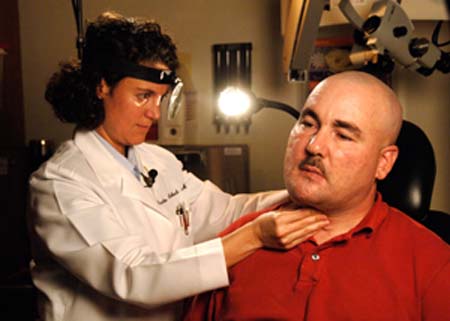Ste reolithography modeling technology in use at Wilford Hall Medical Center at Lackland AFB, Tex., has enabled doctors to repair the jaw of a seriously injured soldier. Army SSgt. Terry Saffron’s jaw was shattered when an improvised explosive device went off near him in Baghdad in 2004. In the aftermath, he suffered debilitating jaw pain and was unable to chew, and Army doctors could not reestablish blood flow to the jaw to keep the bone alive. But working with Wilford Hall’s stereolithography lab, Maj. Cecelia Schmalbach, a medical doctor who oversees head and neck microvascular surgery at the facility, created an exact 3-D model of how Saffron’s jaw should look. With the help of the model, Schmalbach then successfully used a bone, artery, and vein from Saffron’s leg to repair his jaw. He is now able to eat, swallow, and talk again, but still has a ways to go in his recovery. “There is no question in my mind that I could not have achieved the quality of reconstruction and returning this patient to normal occlusion without the aid of the stereolithography models,” said Schmalbach. (Lackland report by MSgt. Kimberly A. Yearyean-Siers)
reolithography modeling technology in use at Wilford Hall Medical Center at Lackland AFB, Tex., has enabled doctors to repair the jaw of a seriously injured soldier. Army SSgt. Terry Saffron’s jaw was shattered when an improvised explosive device went off near him in Baghdad in 2004. In the aftermath, he suffered debilitating jaw pain and was unable to chew, and Army doctors could not reestablish blood flow to the jaw to keep the bone alive. But working with Wilford Hall’s stereolithography lab, Maj. Cecelia Schmalbach, a medical doctor who oversees head and neck microvascular surgery at the facility, created an exact 3-D model of how Saffron’s jaw should look. With the help of the model, Schmalbach then successfully used a bone, artery, and vein from Saffron’s leg to repair his jaw. He is now able to eat, swallow, and talk again, but still has a ways to go in his recovery. “There is no question in my mind that I could not have achieved the quality of reconstruction and returning this patient to normal occlusion without the aid of the stereolithography models,” said Schmalbach. (Lackland report by MSgt. Kimberly A. Yearyean-Siers)
While the Space Force is still making long-term plans to establish high-fidelity live and virtual test and training ranges in the coming years, officials say they're also working with operators to identify near-term gaps and quickly field capabilities to address them.

